Welcome to our comprehensive guide on decoding the world of CTTW in diamond jewelry. BrighterGuide will demystify the concept behind carat total weight, commonly referred to as CTTW, and its crucial role when on the hunt for diamond treasures, be it rings or bracelets.
We will shed light on the nuances between CTTW and individual diamond carat weight, dive into how CTTW influences both price and visual appeal, and touch on other vital facets to weigh when picking a diamond.
So, ready to become a CTTW savant in the realm of diamond jewelry? Let’s embark on this sparkling journey!
Related article: A Guide To Carat Diamond Weight
Key Takeaways
- CTTW (Carat Total Weight) represents the combined weight of all diamonds in a jewelry piece, influencing its overall value and appearance.
- While individual carat weight measures a single diamond’s size and rarity, CTTW considers the weight of every diamond in a piece.
- Beyond just weight, factors such as cut, color, clarity, and design significantly affect a diamond’s quality, price, and overall appeal.
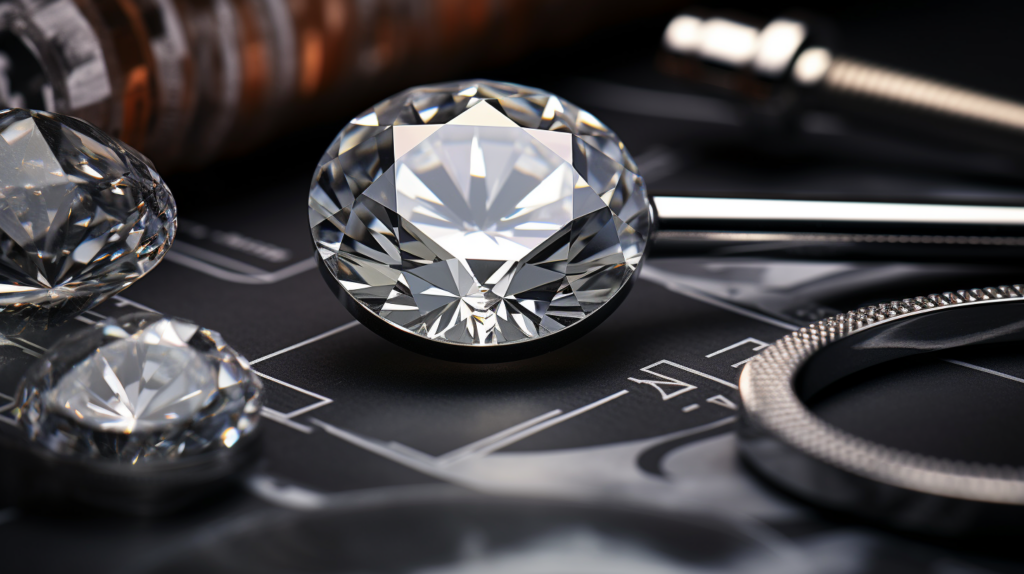
In this post, we’ll explore:
What Does CTTW Mean in a Diamond Ring
In the dazzling world of diamond rings, understanding CTTW is paramount. Standing for carat total weight, CTTW encapsulates the cumulative weight of all diamonds gracing a piece of jewelry, say a ring. Grasping this measurement is pivotal because it offers insight into the aggregate size and grandeur of the diamonds bedecking the ring.
When you’re out shopping for that perfect piece of diamond jewelry, familiarizing yourself with its CTTW can be the key to a wise choice. Depending on the ring’s design and style, CTTW might vary, making it essential in selecting a diamond ring that aligns with your taste and financial reach.
Moreover, CTTW serves as a vital tool when juxtaposing different diamond rings. But it’s worth noting that CTTW is merely a slice of the pie. Elements like cut, hue, and purity equally matter when assessing the ring’s worth and excellence.
Navigating the diamond industry, the weight of diamonds plays a pivotal role. For instance, larger diamonds typically command higher prices, but often the allure lies in a ring’s CTTW. A loose diamond, when set amidst smaller stones, can amplify its brilliance.
While a real diamond has its unique appeal, one must also be aware of synthetic diamonds and lab-grown diamonds flooding the market. James Allen, a recognized name in the diamond world, often emphasizes the distinction between a carat diamond, which is a unit of measurement used, and its overall visual appeal. But for those seeking a blend of elegance and budget-friendliness, a cttw diamond ring, especially one with a 1-carat center stone surrounded by complementary melee diamonds, can be ideal.
James Allen, alongside Family & Co. Jewelers, often presents extensive quality selections for patrons. Their offerings vary from solitaire setting to halo ring diamonds, ensuring that every customer finds their gem. Remember, it’s the balance between a diamond’s CTTW, quality factors, and the design that creates truly beautiful items.
What is a Diamond Carat
Now, let’s delve deeper into what diamond carat weight encapsulates and its role in determining a single diamond’s weight.
- A diamond carat acts as the unit of measurement employed to ascertain the weight of a diamond. To put it in perspective, one carat equates to 200 milligrams or a mere 0.2 grams.
- The weight in carats holds significance in deciding a diamond’s valuation. As a rule of thumb, as the carat weight swells, the diamond’s price climbs too.
- The centerpiece of engagement rings, often referred to as the center diamond or the central stone, usually becomes the showstopper. Many fancy a beefier carat weight for this centerpiece to not just make heads turn but also to mirror the gravity of their pledge.
When you’re out in the market for diamond jewels, especially diamond engagement rings, grasping the carat weight’s essence is non-negotiable. Striking the right equilibrium between carat weight, diamond prices, and personal inclination ensures the engagement ring setting complements the center diamond impeccably.
CTTW vs. Carat: What’s the Difference
It’s pivotal to discern the distinctions between CTTW and individual diamond carat weight in the spectrum of diamond jewelry. While carat weight zeroes in on the heft of an individual diamond, CTTW or carat total weight amalgamates the weights of all diamonds in a jewelry item.
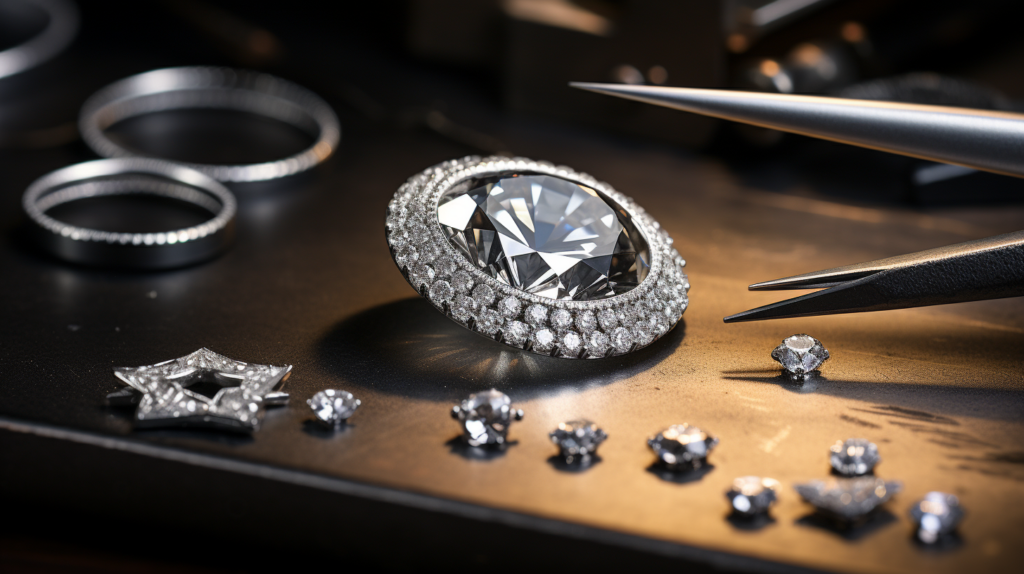
These metrics, albeit related, cater to distinct purposes. While individual carat weight quantifies a lone diamond’s magnitude and rarity, CTTW encapsulates the combined heft of every diamond in the jewelry. A comprehensive grasp of these disparities is invaluable, allowing you to cherry-pick diamond treasures that resonate with your style and spending power.
In evaluating CTTW versus carat, the key difference resides in understanding the collective versus individual weight. While larger stones like a 1 carat solitaire diamond ring can be a showstopper, a piece with the same CTTW may use multiple smaller natural diamonds to achieve that weight.
However, don’t mistake diamond simulants or lab-made diamonds for natural ones; the diamond quality, and not just weight, greatly affects pricing. For instance, a pair of diamond earrings may have a high CTTW, but if they contain yellow diamonds or vary in diamond shape, the price difference may be evident.
While CTTW is a measure of weight and gives an exponential relationship with value, factors like diamond grades or the presence of diamond TW can influence a diamond ring purchase. So, whether you’re looking at basic jewelry or pieces for special occasions, consider both weight and the source, whether they’re genuine diamonds or alternatives like lab-created diamonds.
Remember, the biggest factor in your choice should align with personal preferences and desired customer service benefits.
Total Carat Weight (CTTW) and Diamond Prices
A diamond’s price tag sees a sharp surge with its carat weight. However, a ring’s overall carat weight doesn’t always linearly dictate its valuation. Beyond mere weight, a plethora of factors influence diamond prices:
- Budget-Friendliness: Rings that boast a substantial total carat weight but flaunt a smaller center stone might be lighter on the pocket. Owing to the fact that tinier diamonds usually cost less, you can achieve a substantial look without breaking the bank with such rings.
- Setting Styles: Opting for halo or pavé settings, characterized by a rich total carat weight, can achieve a luxe look without the hefty price tag. These designs employ petite diamonds set snugly to craft an illusion of a larger solitaire diamond. So, even if the diamonds are relatively small, the resultant effect can be genuinely awe-inspiring.
- Personal Preference: The final say on the total carat weight invariably boils down to one’s personal choice. Some might be swayed by a chunky center stone and a relatively modest CTTW, while others might favor a bountiful CTTW studded with petite diamonds. Your unique style and palate should be at the forefront when hunting for the perfect diamond ring.
Other Factors to Look For in a Diamond
Besides carat weight, diamonds encompass a suite of elements, notably cut, color, and clarity, each contributing to its overall quality and worth.
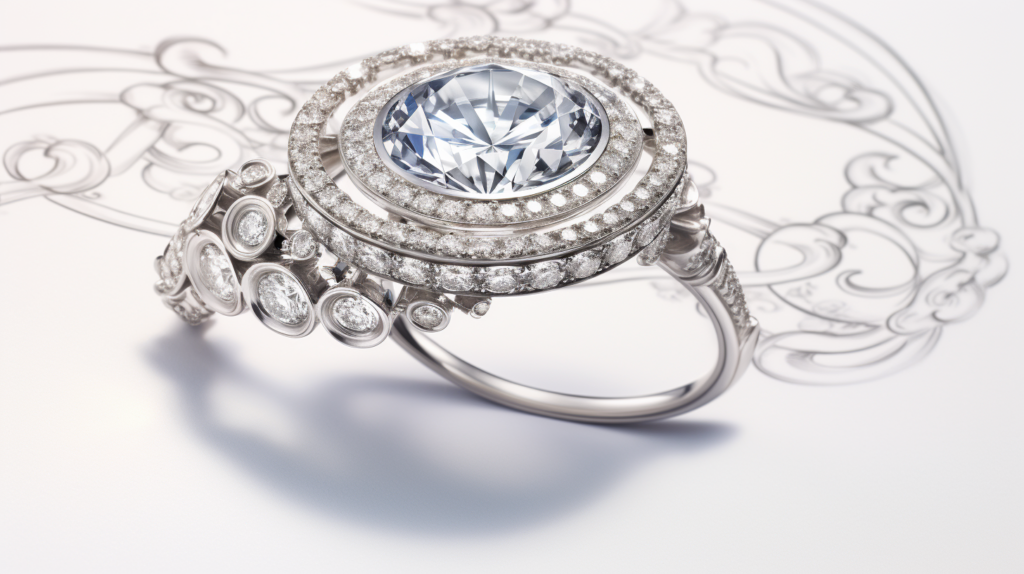
The diamond’s cut speaks volumes about its crafting finesse, influencing its luminosity and glint. The color grading evaluates the presence or absence of hues within a diamond, with top-tier grades signifying minimal color. Clarity zeroes in on any inclusions or blemishes, potentially impacting the diamond’s visual appeal.
Furthermore, the shape and magnitude of a diamond should align with personal aesthetic preferences and style. In engagement rings, for instance, the central stone invariably steals the spotlight, necessitating careful selection.
Surrounding the primary diamond are accent diamonds. These could line the band or encircle the central diamond, amplifying the ring’s overall charm. Noteworthy options in this realm include halo engagement settings wherein the main diamond is circumscribed by smaller gems, conjuring an ethereal shimmer.
What Does 1 CTTW Mean in Jewelry
CTTW in jewelry signifies the collective weight of all diamonds integrated into a particular item. If a jewelry piece is described as having a 1 CTTW diamond, it denotes that the combined weight of its diamonds sums up to 1 carat.
To break down what 1 CTTW implies in jewelry:
- Cumulative Weight: A 1 CTTW diamond might stem from a solitary diamond weighing an entire carat or could be a medley of smaller diamonds whose combined weight touches 1 carat.
- Expressed in Carats: Carats serve as the gold standard for gauging diamond weights. Thus, a 1 CTTW translates to a total diamond weight of 1 carat.
- Diamond Weight Variability: The flexibility of CTTW becomes evident in diverse diamond arrangements. For instance, a jewelry piece could spotlight a 0.75-carat center diamond and be adorned with smaller diamonds totaling 0.25 carats, reaching the 1 CTTW mark.
It’s paramount to note that as the CTTW of a diamond ascends, the diamond’s weight in carats substantially dictates its look and worth. Thus, when evaluating a 1 CTTW diamond, it becomes essential to dissect the weights of individual diamonds and their contribution to the jewelry’s holistic aura.
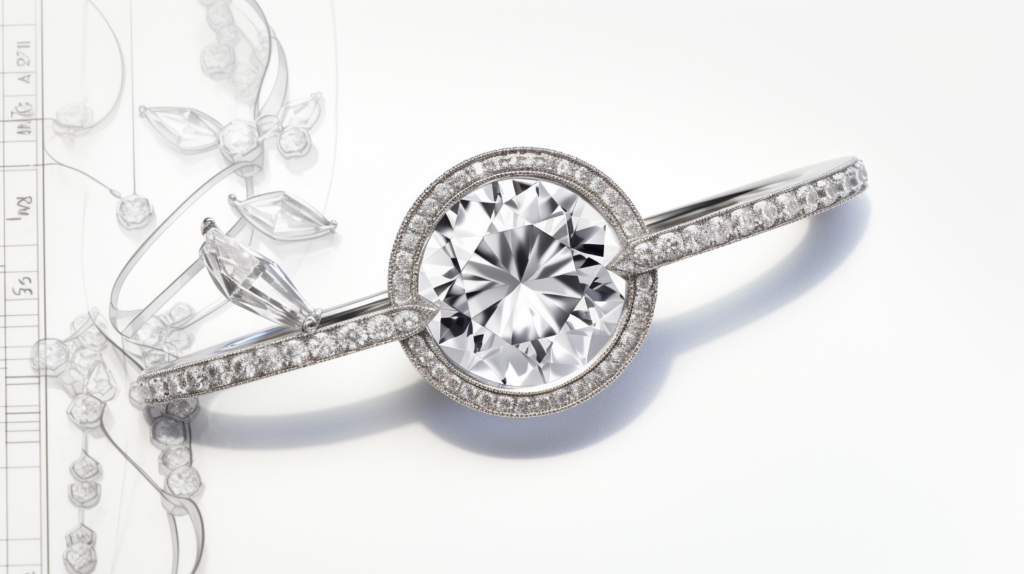
Total Carat Weight in Diamond Earrings
When it’s about diamond earrings, harmonizing the desired aesthetic with the appropriate total carat weight is vital. Here, CTTW mirrors the cumulative weight of all diamonds in both earrings, influencing their comprehensive allure and worth.
Arming oneself with the CTTW knowledge when selecting diamond earrings can assist in gauging the diamond’s size and grandeur. Whether the choice leans towards subtle, elegant studs or opulent, statement danglers, CTTW remains an influential determinant.
Beyond CTTW, aspects like diamond cut quality, diamond ratings, and the prominence of the diamond piece play pivotal roles in amplifying the earrings’ beauty and splendor. Educating oneself about these facets ensures a well-informed purchase that exudes brilliance and sophistication.
With the diamond market bursting at its seams with an array of diamond earrings, each boasting varied carat weights, grounding one’s choice in personal style, budgetary considerations, and preferences becomes imperative. A robust understanding of CTTW coupled with other pertinent elements ensures a selection that mirrors one’s desires and expectations.
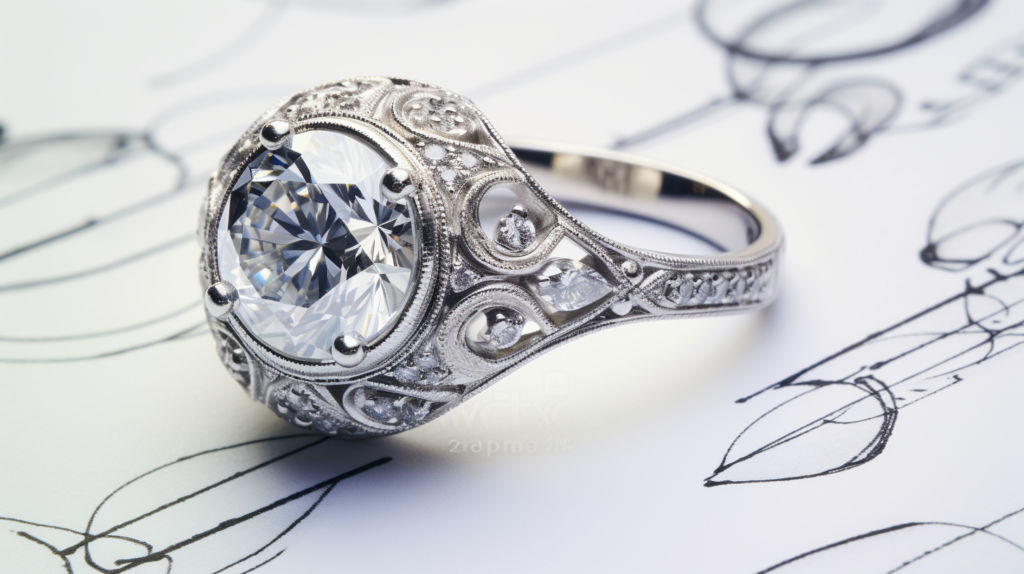
Conclusion
In our odyssey through the realm of CTTW in diamond jewelry, we’ve demystified its essence and its pivotal role in shaping a diamond piece’s value and aesthetics. Grasping the intricacies of total carat weight becomes non-negotiable, especially when eyeing diamond trinkets for monumental occasions like engagements.
To encapsulate:
- CTTW and Valuation: While a larger solo diamond tends to command top dollar, a piece sporting a generous CTTW but a more modest central stone might be gentler on the wallet.
- CTTW and Aesthetics: The sum total of diamond weights significantly dictates a diamond ring’s visual punch. Settings like clusters, using closely-knit tiny diamonds, can mimic the allure of a heftier solitaire diamond ring.
- CTTW and Excellence: Carat weight is merely the tip of the iceberg. Aspects such as the 4 Cs of diamonds—cut, color, clarity, and carat—play pivotal roles in determining a diamond’s quality and worth. A comprehensive evaluation ensures you’re not only captivated by its sparkle but also by its supreme quality.
With the shimmering world of diamonds laid bare, may your journey to find that perfect sparkle be illuminated with informed choices and dazzling delights!
Sources
BrighterGuide is dedicated to providing accurate and relevant information as you explore the wonderful world of diamonds and jewelry. To this end, our writers refer to primary information sources in building each article that appears on this website. These include, but are not limited to, published news articles, government portals, research papers, and more.
- Learn what carat means and what diamond carat measures | 4Cs of Diamond Quality by GIA. (2019b, December 9). GIA 4Cs. https://4cs.gia.edu/en-us/diamond-carat-weight/
- American Gem Society. (2023c, May 23). Buying Diamonds | Understanding Diamond Carat Weight – AGS. https://www.americangemsociety.org/buying-diamonds-with-confidence/4cs-of-diamonds/understanding-diamond-carat-weight-the-4cs-of-diamonds/